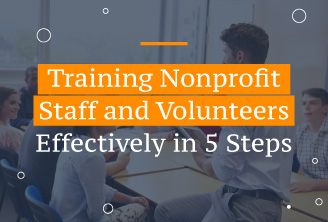
Remember Captain Obvious? He was a character invented not long ago to sell bookings on Hotels.com. If he was on television today, he’d be telling us, “In 2020, the world changed.” No kidding!
But what a lot of people are expecting (really, hoping) is that after a while, we’ll go back to normal. Not so fast.
The world has changed a lot, and it’s not likely to get back to the old normal. Instead, it’s creating a new normal entirely. But are you ready? More importantly, are your staff and volunteers ready and trained to perform productively in their roles?
Here are five steps to get them there.
Step 1: Assess your position.
Just about every nonprofit made major changes in 2020. Like a balloon that you inflate and let the air escape from, your nonprofit isn’t going to look the same after.
Your first step is defining what your mission and programs will look like in an adjusted environment.
If you created new service delivery methods, you may find that your constituents don’t want to go back. There’s convenience in online connections, and a new appreciation for safety in “touchless” program delivery. (Hint: If your constituents are more comfortable now with virtual opportunities to lend their support, check out Fundly’s list of virtual fundraising ideas to get inspired for your next campaign.)
Then there’s your workforce—both paid and volunteer. You probably learned that not everyone needs to be in your office to effectively carry out their jobs. You also found out who was required to be there like, for example, workers who dealt with physical goods and or those who had to treat patients.
How about your revenue sources? Chances are they changed. A lot went away, and some opened up. For example, if you relied on income from personally interacting with customers, such as ticketed events, shows, and stores, you had major adjustments. Some went virtual, and others simply closed. On the other hand, new grant opportunities came to light, and if you were good at identifying them, you made your case to individual donors. Now ask yourself, what changes are going to stay attractive for your donors?
This is just a taste. Marketing, facilities, budgeting, management, and everything else has changed, too—if not how you did them, then who accomplished the tasks, and where. Most importantly, with all of these changes, your team’s roles changed, too.
Step 2: Person by person, redefine their role.
There’s no doubt that just about everyone’s role changed in 2020. Some changed just a little. A data entry clerk may have just changed the location from which the data was entered and the workflow to receive it. Others changed a lot, like the person who supports your technology infrastructure or the people who have direct patient contact.
People changed, too. Some grew and matured with the experience. Others redefined personal and professional values. A few stepped back or even left.
What you could be finding is that the organizational chart stayed largely the same, but now, not everyone fits where they were before. There’s going to be a few instances where the misfit is so obvious that it’s clear a new role is necessary—inside or outside your organization. But typically, the job someone had at the end of 2019 or the person doing it will have changed just enough that with some education and training in new skills, the organization and the person can thrive.
Step 3: Make a training plan.
 Today is the day you’re going to shed the “vacation” mentality of training your nonprofit staff and volunteers. Now more than ever, you can’t afford to treat training and the time required away from your office as a perk for a job well done with no real changes after the training is complete.
Today is the day you’re going to shed the “vacation” mentality of training your nonprofit staff and volunteers. Now more than ever, you can’t afford to treat training and the time required away from your office as a perk for a job well done with no real changes after the training is complete.
Each person on your team needs an education plan that becomes part of their ongoing performance evaluation, including expectations of work changes and improvement after their training.
It sounds like a huge job, right? Not if you ask the right person—the one who knows their job the best—to start creating their plan for each staff member and volunteer.
Yes, their manager likely has the big picture in mind, but who knows better how the changes in the last year transformed their world than the person doing it? What problems still vex them? What did they learn by trial and error that would be great to get formal training in? Where are the roadblocks to efficiency?
Your training plan needs to have three basic elements, as described in the following questions:
- What is the problem or issue that’s currently facing your team?
- What training would help address that problem, and why?
- What specific, measurable results will occur once that training is complete?
Take revenue generation as an example. Let’s say that your contributions from direct mail donors of less than $1,000 fell off by 60% in 2020 as compared to the previous year. This was because you had to cut your budget, and the volunteers who usually helped with mailings weren’t available—so no mailings were sent. Not wanting to end all donor communication, you shifted into email and social media, but it was all DIY. You didn’t know how to grow your market, so you simply pushed out more messaging and prayed.
However, an effective training process can mitigate these struggles by informing your team of fundraising strategy best practices and coordinated communications. As a result, you can grow your overall donor base, retain more long-term supporters, and get more dollars into your programming.
Step 4: Reward success.
According to Nonprofit.Courses’ guide to nonprofit professional development, your volunteers and staff are assets. Let them know that they are assets by incorporating rewards into your training efforts. The key is not to use training as a reward, but to reward the impact that occurs after the training your staff and volunteers. However, you need to be careful with doing so. Few seminars guarantee results, even if you implement everything they taught to the letter. In rewarding training, you need to reward the process rather than the results themselves.
The result of the training program outlined above could be the planning and implementation of an effective direct-response strategy that includes social media, email, and direct mail, and costs less than your old direct mail-only program.
Now that you’ve seen the results of the training put into place, offer a perk—like a day off, a gift card, tickets to an event, branded merch, or whatever you find your people will value in the context of your organization. It’s important to be obvious. Make sure that the person knows that the reward is a direct result of successfully implementing whatever was learned at their training.
Step 5: Reevaluate.
Every person in your organization—staff, volunteers, and board members alike—need an annual evaluation of their performance. This is a chance to determine the effectiveness of their training, take a closer look at results, and make plans for ongoing training.
For example, did the plan that resulted from the aforementioned fundraising training result in increased donors and donations? Everyone loves success, and training your staff and volunteers should be recognized as part of it.
However, while success can be credited to hard work, great staff, and good training, failure can’t be blamed on bad training alone. In the end, while you may recognize deficiencies in training, the person’s goals are their own responsibility.
The Bottom Line
It’s abundantly clear that everyone’s job has changed from the “good ol’ days” of 2019. That makes training and education more critical than ever as staff and volunteers adapt to their adjusted roles. But effective training your staff and volunteers can’t be random or simply function as a reward for a job well done.
From the top leadership to your mission delivery staff and your office clerks, training your staff and volunteers needs to be a planned, systematic response to your new conditions so that each person, and in turn, your entire nonprofit, can thrive in our new normal.
About the Author

Matt Hugg is an author and instructor in nonprofit management in the US and abroad. He is president and founder of Nonprofit.Courses, an on-demand, eLearning educational resource for nonprofit leaders, staff, board members and volunteers, with thousands of courses in nearly every aspect of nonprofit work.
He’s the author of The Guide to Nonprofit Consulting, and Philanders Family Values, Fun Scenarios for Practical Fundraising Education for Boards, Staff and Volunteers, and a contributing author to The Healthcare Nonprofit: Keys to Effective Management.
Over his 30-year career, Hugg has held positions at the Boy Scouts of America, Lebanon Valley College, the University of Cincinnati, Ursinus College, and the University of the Arts. In these positions, Matt raised thousands of gifts from individuals, foundations, corporations and government entities, and worked with hundreds of volunteers on boards and fundraising committees, in addition to his organizational leadership responsibilities.
Matt teaches fundraising, philanthropy, and marketing in graduate programs at Eastern University, the University of Pennsylvania, Juniata College and Thomas Edison State University via the web, and in-person in the United States, Africa, Asia and Europe, and is a popular conference speaker. He has a BS from Juniata College and an MA in Philanthropy and Development from St. Mary’s University of Minnesota. Mr. Hugg has served on the board of the Greater Philadelphia Chapter of the Association of Fundraising Professionals, the Nonprofit Career Network of Philadelphia and several nonprofits.






Leave A Comment